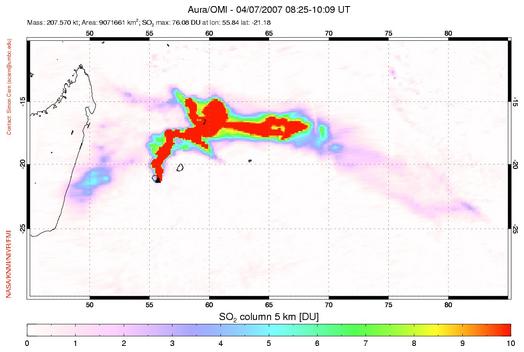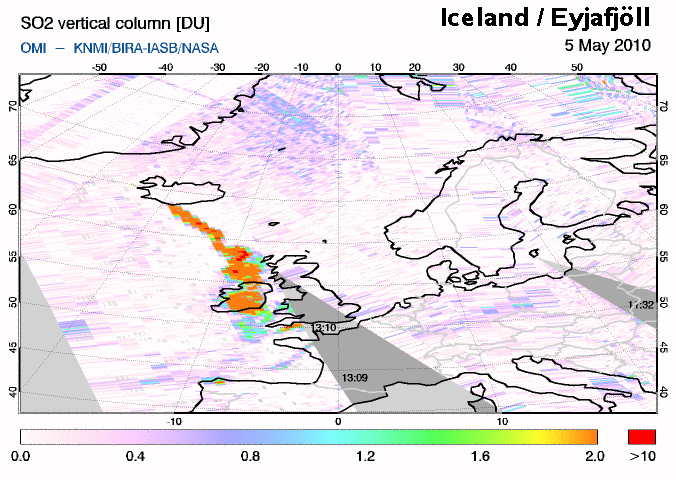SO2 total column based on OMI data
The SO2 data product based on observations of the SCIAMACHY and GOME-2 instruments are determined using a DOAS algorithm to determine the slant column density followed by the use of an
AMF pre-determined with a radiative transfer model to find the vertical (total) column density.
The SO2 data product based on OMI data is derived quite differently --
namely with a "band residual method" using the residuals of the DOAS-based
ozone retrieval -- and it does not give a comparable slant column density as
intermediate step. The method used for OMI should in principle lead to the
same SO2 total column as those derived with the other methods.
The OMI data product file contains three estimates of the total SO2
column in Dobson Units. These correspond to three a-priori vertical
profiles for the SO2 vertical distribution used in the retrieval algorithm.
The three vertical profiles were selected to represent typical SO2 vertical
distributions for three SO2 source regimes: SO2 in the Planetary Boundary
Layer (PBL, below 2 km) from anthropogenic sources, SO2 distributed between
5 and 10 km emitted by passive volcanic degassing in the free troposphere,
and SO2 distributed between 15 and 20 km representing injection from
explosive volcanic eruptions.

|
|
SO2 total column based on OMI measurements on 7 April 2007. The SO2 plume
is related to the eruption of the Piton de la Fournaise volcano on
Reunion Island, which started a few days earlier and continued for several
days. [Image courtesy Simon Carn, OMI/NASA.]
|
In the OMSO2 product, all PBL data are processed with the Band Residual
Difference (BRD) method, while all 5 km and 15 km data are
processed with the Linear Fit (LF) algorithm. The algorithms use different
subsets of calibrated residuals produced by the NASA operational ozone
algorithm. This set contains residuals centered at the Earth Probe (EP) TOMS
wavelengths, four residuals at extrema of the SO2 absorption cross-section
from 310.8 nm to 314.4 nm, and two non-absorbing wavelengths at 345 nm and
370 nm. Both OMSO2 algorithms use the temperature-dependent SO2
cross-sections data, residual correction for background regions, and
different parameterizations of the AMF.
The BRD algorithm uses differential residuals at 3 SO2 sensitive OMI UV2
wavelength pairs, and the pair average is used to produce all PBL data. A
constant AMF of 0.36 is used to estimate total SO2 (vertical column).
For strong volcanic degassing and eruptions, SO2 loading can be very large
and the BRD algorithm may fail. The LF algorithm has been developed to
optimally select residuals from the set of available OMTO3 bands to retrieve
SO2 under these conditions.
The LF algorithm minimizes a subset of the residuals by simultaneously
adjusting total SO2, total column ozone, reflectivity at 331 nm, and
polynomial coefficients (linear and quadratic) to account for the wavelength
dependent effect of surface albedo and aerosol on the effective
reflectivity.
More information, references and links regarding the OMI SO2 data product
can be found at the website of the
Aura OMI Sulphur
Dioxide Data Product
See also the website of the
OMI Sulphur Dioxide Group
OMI SO2 data presented on this web site

This website contains maps (plots) of the SO2 distribution based on OMI
measurements. The maps presented here use exactly the same colour bar as is
used for data of other satellites, so that it is easy to compare the
results.
The image here shows the SO2 distribution over North Occidental Europe. The times of the measurement are plotted at the middle of each orbit, once every 50 swaths. The image also shows bands of no data.
Note that in the NRT service only images are shown; data files are not
supplied. The archive service provides images and links to data files.
|